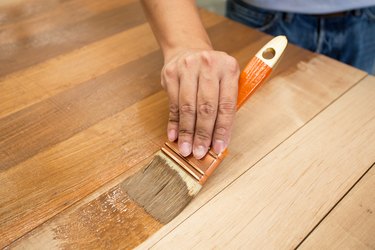
Tinting a clear finish like varnish isn't a crazy idea. A tinted varnish is a type of glaze, and people use glazes all the time to add tone and color to woodwork, painted surfaces, and more. You can tint both water- and oil-based varnishes, and you can make glazes from other finish materials, such as lacquer and shellac.
There's more than one way to tint varnish. You can mix it with a stain that has the color you want, or you can use artists' pigments, like cadmium red or cobalt green, but the easiest way is to use universal colorants available at any paint store. Colorants are handy because they mix with any finish, whether it's oil- or water-based, and they aren't too expensive. Of course, if tinting your own varnish isn't your thing, you can always buy wood-tone tinted varnishes online or at any paint store or home improvement outlet.
Video of the Day
Video of the Day
Mixing Varnish With Stain
While mixing varnish with stain is a tinting option, it has limitations. The maximum stain concentration shouldn't exceed 20 percent, or the varnish film will lose some of its protective qualities. However, if you do exceed this concentration, you produce what is known as a wiping varnish, which is one that sinks into the pores of the wood and could be advantageous in some situations. The other limitation, however, is that the final color will always be lighter than that of the stain no matter what mix ratio you use.
To be on the safe side, always mix stains and varnishes from the same manufacturer and definitely make sure they have the same solvent base because oil and water don't mix. Mix the two products in a third container up to the desired ratio and stir well. You may have to stir frequently during application because the pigments tend to settle.
Advantages of Using Pigments and Colorants
The number one advantage of tinting varnish with universal colorants or artists' pigments is that you can mix them to create just the color you want, and there's no limitation on the depth of the hue. If you add enough colorant, you can make the finish nearly opaque, although because varnish has a clear base, it will always retain a translucent quality.
The colors you're most likely to use are the earth tones, including raw and burnt sienna, raw and burnt umber, yellow ocher, and similar tones, but there's no reason you can't include primary reds, greens, blues, and other paint tints. Tinting varnish with primary colors can be an offbeat way to brighten up a piece of furniture, and it can add new life to a piece painted with the same colors you use for tinting.
Tips for Tinting Varnish With Colorants
The main thing to remember when tinting varnish with pigments and colorants is that a little goes a long way. A few drops of colorant or dashes of powdered pigment will have a dramatic effect, and since you don't have a computer to guide you as they do at the paint store, you'll need to experiment. Work with a sample before you colorize all the varnish you plan to use.
In general, it's best to stay with a single color because mixing colors doesn't always produce the hue you were expecting. If you have to mix, you'll get more predictable results if you make two samples of different colors and mix those rather than combining two colorants or pigments in a single sample. If you're trying to get a particular hue, you're better off having the varnish tinted at a paint store where a computer can recommend the exact pigment proportions to achieve it.